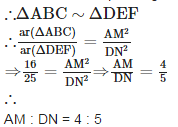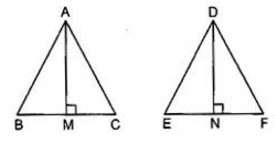Class 10 Exam > Class 10 Questions > Two isosceles triangles have equal angles and...
Start Learning for Free
Two isosceles triangles have equal angles and their areas are in the ratio 16 : 25. Then, the ratio of their corresponding heights is
- a)3/5
- b)5/4
- c)5/7
- d)4/5
Correct answer is option 'D'. Can you explain this answer?
Verified Answer
Two isosceles triangles have equal angles and their areas are in the r...
Let two isosceles triangles be ΔABC and ΔDEF And their corresponding altitudes are AM and DN.
Since the corresponding angles of both triangles are equal.


Since the corresponding angles of both triangles are equal.
Most Upvoted Answer
Two isosceles triangles have equal angles and their areas are in the r...
Problem:
Two isosceles triangles have equal angles and their areas are in the ratio 16 : 25. Find the ratio of their corresponding heights.
Solution:
Let's assume that the two isosceles triangles have bases of lengths b1 and b2, and heights of lengths h1 and h2 respectively. The given information states that the areas of the triangles are in the ratio 16:25.
We know that the area of a triangle can be calculated using the formula:
Area = (1/2) * base * height
Step 1: Establishing the area ratio:
Since the triangles have equal angles, their bases are proportional. Therefore, we can write:
b2 = kb1
where k is a constant.
The area ratio is given as 16:25, so we can write:
(1/2) * b1 * h1 : (1/2) * b2 * h2 = 16 : 25
Substituting the values of b2 and kb1, we get:
(1/2) * b1 * h1 : (1/2) * kb1 * h2 = 16 : 25
Simplifying the equation, we get:
h1 : h2 = 16 : (25/k)
Step 2: Finding the value of k:
To find the value of k, we can use the fact that the sum of the angles in a triangle is 180 degrees. Since the triangles have equal angles, we can write:
2x + 2x + x = 180 degrees
(where x is the value of each angle)
Simplifying the equation, we get:
5x = 180 degrees
x = 36 degrees
Now, we can use the sine rule to find the value of k:
sin(x) = b1 / h1
sin(36 degrees) = b1 / h1
Similarly, for the second triangle:
sin(x) = b2 / h2
sin(36 degrees) = kb1 / h2
Dividing the two equations, we get:
h1 / h2 = b1 / (kb1)
h1 / h2 = 1 / k
Since h1 / h2 = 16 / (25/k), we can equate the two ratios:
1 / k = 16 / (25/k)
Cross multiplying, we get:
k^2 = 16 * 25
k^2 = 400
k = 20
Step 3: Finding the ratio of heights:
Substituting the value of k in the equation h1 : h2 = 16 : (25/k), we get:
h1 : h2 = 16 : (25/20)
h1 : h2 = 16 : 5
Therefore, the ratio of the corresponding heights of the two isosceles triangles is 16:5, which can be simplified to 4:5. Hence, the correct answer is option D) 4/5.
Two isosceles triangles have equal angles and their areas are in the ratio 16 : 25. Find the ratio of their corresponding heights.
Solution:
Let's assume that the two isosceles triangles have bases of lengths b1 and b2, and heights of lengths h1 and h2 respectively. The given information states that the areas of the triangles are in the ratio 16:25.
We know that the area of a triangle can be calculated using the formula:
Area = (1/2) * base * height
Step 1: Establishing the area ratio:
Since the triangles have equal angles, their bases are proportional. Therefore, we can write:
b2 = kb1
where k is a constant.
The area ratio is given as 16:25, so we can write:
(1/2) * b1 * h1 : (1/2) * b2 * h2 = 16 : 25
Substituting the values of b2 and kb1, we get:
(1/2) * b1 * h1 : (1/2) * kb1 * h2 = 16 : 25
Simplifying the equation, we get:
h1 : h2 = 16 : (25/k)
Step 2: Finding the value of k:
To find the value of k, we can use the fact that the sum of the angles in a triangle is 180 degrees. Since the triangles have equal angles, we can write:
2x + 2x + x = 180 degrees
(where x is the value of each angle)
Simplifying the equation, we get:
5x = 180 degrees
x = 36 degrees
Now, we can use the sine rule to find the value of k:
sin(x) = b1 / h1
sin(36 degrees) = b1 / h1
Similarly, for the second triangle:
sin(x) = b2 / h2
sin(36 degrees) = kb1 / h2
Dividing the two equations, we get:
h1 / h2 = b1 / (kb1)
h1 / h2 = 1 / k
Since h1 / h2 = 16 / (25/k), we can equate the two ratios:
1 / k = 16 / (25/k)
Cross multiplying, we get:
k^2 = 16 * 25
k^2 = 400
k = 20
Step 3: Finding the ratio of heights:
Substituting the value of k in the equation h1 : h2 = 16 : (25/k), we get:
h1 : h2 = 16 : (25/20)
h1 : h2 = 16 : 5
Therefore, the ratio of the corresponding heights of the two isosceles triangles is 16:5, which can be simplified to 4:5. Hence, the correct answer is option D) 4/5.

|
Explore Courses for Class 10 exam
|

|
Question Description
Two isosceles triangles have equal angles and their areas are in the ratio 16 : 25. Then, the ratio of their corresponding heights isa)3/5b)5/4c)5/7d)4/5Correct answer is option 'D'. Can you explain this answer? for Class 10 2025 is part of Class 10 preparation. The Question and answers have been prepared according to the Class 10 exam syllabus. Information about Two isosceles triangles have equal angles and their areas are in the ratio 16 : 25. Then, the ratio of their corresponding heights isa)3/5b)5/4c)5/7d)4/5Correct answer is option 'D'. Can you explain this answer? covers all topics & solutions for Class 10 2025 Exam. Find important definitions, questions, meanings, examples, exercises and tests below for Two isosceles triangles have equal angles and their areas are in the ratio 16 : 25. Then, the ratio of their corresponding heights isa)3/5b)5/4c)5/7d)4/5Correct answer is option 'D'. Can you explain this answer?.
Two isosceles triangles have equal angles and their areas are in the ratio 16 : 25. Then, the ratio of their corresponding heights isa)3/5b)5/4c)5/7d)4/5Correct answer is option 'D'. Can you explain this answer? for Class 10 2025 is part of Class 10 preparation. The Question and answers have been prepared according to the Class 10 exam syllabus. Information about Two isosceles triangles have equal angles and their areas are in the ratio 16 : 25. Then, the ratio of their corresponding heights isa)3/5b)5/4c)5/7d)4/5Correct answer is option 'D'. Can you explain this answer? covers all topics & solutions for Class 10 2025 Exam. Find important definitions, questions, meanings, examples, exercises and tests below for Two isosceles triangles have equal angles and their areas are in the ratio 16 : 25. Then, the ratio of their corresponding heights isa)3/5b)5/4c)5/7d)4/5Correct answer is option 'D'. Can you explain this answer?.
Solutions for Two isosceles triangles have equal angles and their areas are in the ratio 16 : 25. Then, the ratio of their corresponding heights isa)3/5b)5/4c)5/7d)4/5Correct answer is option 'D'. Can you explain this answer? in English & in Hindi are available as part of our courses for Class 10.
Download more important topics, notes, lectures and mock test series for Class 10 Exam by signing up for free.
Here you can find the meaning of Two isosceles triangles have equal angles and their areas are in the ratio 16 : 25. Then, the ratio of their corresponding heights isa)3/5b)5/4c)5/7d)4/5Correct answer is option 'D'. Can you explain this answer? defined & explained in the simplest way possible. Besides giving the explanation of
Two isosceles triangles have equal angles and their areas are in the ratio 16 : 25. Then, the ratio of their corresponding heights isa)3/5b)5/4c)5/7d)4/5Correct answer is option 'D'. Can you explain this answer?, a detailed solution for Two isosceles triangles have equal angles and their areas are in the ratio 16 : 25. Then, the ratio of their corresponding heights isa)3/5b)5/4c)5/7d)4/5Correct answer is option 'D'. Can you explain this answer? has been provided alongside types of Two isosceles triangles have equal angles and their areas are in the ratio 16 : 25. Then, the ratio of their corresponding heights isa)3/5b)5/4c)5/7d)4/5Correct answer is option 'D'. Can you explain this answer? theory, EduRev gives you an
ample number of questions to practice Two isosceles triangles have equal angles and their areas are in the ratio 16 : 25. Then, the ratio of their corresponding heights isa)3/5b)5/4c)5/7d)4/5Correct answer is option 'D'. Can you explain this answer? tests, examples and also practice Class 10 tests.

|
Explore Courses for Class 10 exam
|

|
Signup for Free!
Signup to see your scores go up within 7 days! Learn & Practice with 1000+ FREE Notes, Videos & Tests.


















